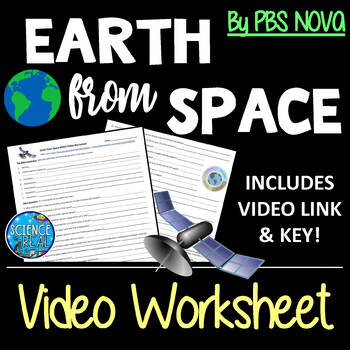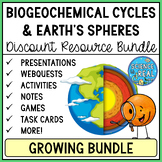Earth From Space Documentary by NOVA Video Worksheet - With FREE Video Link!
- Zip
Also included in
- ⭐ ⭐ ⭐ ⭐ This Biogeochemical Cycles and Spheres Bundle is a growing collection of all my resources designed to teach these topics to secondary science students (grades 7-12).This growing bundle is priced at over 30% off! By purchasing the biogeochemical cycles and spheres growing bundle, you get allPrice $85.23Original Price $123.23Save $38.00
- ⭐ ⭐ ⭐ ⭐ ⭐ Save Over 30% with this growing collection of all things earth science and astronomy! This is a growing collection of secondary earth science, space science, and astronomy resources. If you purchase this growing bundle today, you will receive all future added resources for free, for life!Price $456.99Original Price $653.00Save $196.01
- ⭐ ⭐ ⭐ ⭐ ⭐ Save over 30% with this growing collection of astronomy resources! This bundle includes everything I've created and will create for grades 8-12 astronomy in one place and a heavily discounted price!⭐ Click on the preview to download more information about this bundle and a digital interactPrice $159.99Original Price $230.90Save $70.91
Description
⭐⭐⭐Every science student needs to watch this free documentary provided by PBS Nova. This video explains and engages students to learn about the interconnection and interactions between Earth’s spheres and biogeochemical cycles. It also covers the EM Spectrum, weather, climate, and climate change.
You will receive a 2-page editable video handout (word and PDF) includes sequenced questions to accompany PBS NOVA’s Earth From Space Documentary. Answer key contains time stamps, the time the student will find the answer within the film.
⭐The video is free and found on the PBS website HERE or on YouTube HERE.
Topics Include
- Earth's Spheres
- Biogeochemical Cycles
- Ocean Circulation
- Weather and Climate
- Clouds
- Magnetic Field
- Electromagnetic Spectrum
- Satellites
The student handout includes 7 video preview questions, 43 short answer questions, and 2 summarizing analysis questions. The questions are formatted short-answer style, however no answer is much longer than 1-3 words. The questions are spaced out so that they do not go too fast or too slow and encompass the entire film from start to finish.
Description from PBS NOVA - “Earth From Space is a groundbreaking two-hour special that reveals a spectacular new space-based vision of our planet. Produced in extensive consultation with NASA scientists, NOVA takes data from earth-observing satellites and transforms it into dazzling visual sequences, each one exposing the intricate and surprising web of forces that sustains life on earth. Viewers witness how dust blown from the Sahara fertilizes the Amazon; how a vast submarine "waterfall" off Antarctica helps drive ocean currents around the world; and how the Sun's heating up of the southern Atlantic gives birth to a colossally powerful hurricane. From the microscopic world of water molecules vaporizing over the ocean to the magnetic field that is bigger than Earth itself, the show reveals the astonishing beauty and complexity of our dynamic planet.”
This handout is perfect for an introduction or enrichment to the Earth’s spheres and cycles, a great sub-plan, enrichment, or lesson all in its own right. It’s perfect for Earth Space Science, Environmental Science, Astronomy, or Biology standards.
Just Print and Go! Fits on 1 sheet of paper (front & back)!
Answer Key Included!
PERFECT SUB PLAN!
Click on the Preview to see more!
Key Words: NGSS, Earth Documentary, Space Documentary, Video Questions, Earth's biogeochemical cycles, Earth's systems, Earth's Spheres, Electromagnetic Spectrum, Hydrosphere, Ocean Circulation, Weather, Climate Change, Interactions Between Earth's Spheres and Cycles
Science Is Real! Terms of Use (TOU):
- Purchase of the product is for single classroom use by the purchaser only. It is a violation for individuals, schools, and districts to redistribute, edit, sell, or post this item on the Internet or to other individuals. Disregarding the copyright is a violation of the Digital Millennium Copyright Act and subject to legal action.
-By purchasing this product you acknowledge that you have read and understood the Terms of Use.
❤️CLICK TO FOLLOW SCIENCE IS REAL! ❤️
Get Discounts and FREEBIES!
HAPPY SCIENCING!
❤️ CHECK OUT MORE GREAT THINGS FROM SCIENCE IS REAL! ❤️
⭐ Earth's Spheres and Biogeochemical Cycles GROWING BUNDLE! - Distance Learning
⭐ Biogeochemical Cycles Diagram, Coloring, and Analysis Questions Worksheets - 3!
⭐ Biogeochemical Cycles Review Taboo Game
⭐ Biogeochemical Cycles WebQuest
⭐ Biogeochemical Cycles and Earth's Spheres Printable Board Game WITH Questions!
⭐ Earth's Spheres - Boom Cards - Task Cards - Distance Learning
⭐ Earth's Spheres PowerPoint, Notes, Crossword, and KAHOOT!
⭐ Layers of the Atmosphere Worksheet - Coloring, Labeling Diagrams, Questions
⭐ Severe Weather Webquest - Distance Learning
⭐ Weather Documentary Worksheet with Free Video Link: BBC's Wild Weather Episode 3
⭐ Weather Graphic Organizers with Reference Sheet and Key!
⭐ Weather Map Activity - Weather, Fronts, Pressure, & Precipitation
⭐ Weather PowerPoint: Air Masses, Fronts, Air Pressure, & Weather Maps with Notes!
⭐ Weather Webquest - Distance Learning
⭐ Electromagnetic Spectrum Graphic Organizer - Distance Learning
⭐ Electromagnetic Spectrum WebQuest
⭐ Cosmos Episode 10 Worksheet: The Electric Boy - Cosmos A Spacetime Odyssey
************************************************************************
❤️ Read What Others Have Said About Science Is Real’s Resources! ❤️
“Great Last-Minute Sub Plan!”
“Best resource. The students were engaged the whole time.”
“Awesome, just awesome.”
“Great Introduction to Our Unit!”
“This was a huge time saver for me and it made learning more interesting for my students. Thank you!”
“This is exactly what I was looking for!:) Thank you so much for saving me the time and energy at a time when my gas tank is empty.”
*************************************************************************







